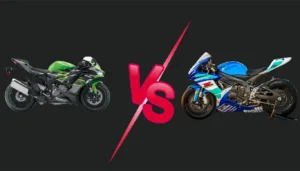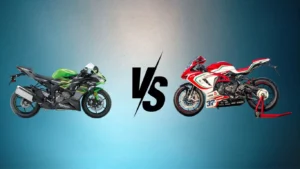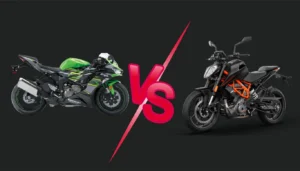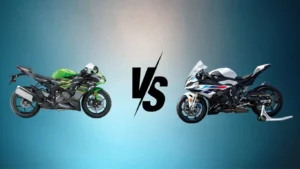If you’re a passionate rider in search of your next adrenaline-pumped experience, you’ve likely found yourself torn between two outstanding motorcycles: the Kawasaki Ninja ZX-6R and the Suzuki GSX-R600. Both of these bikes have a reputation for delivering performance and speed that can ignite the love for riding in any motorcycle enthusiast’s heart.
However, picking one over the other can be surprisingly challenging. This guide aims to present a detailed comparative analysis between these two high-performance motorcycles, examining them based on their performance, features, and price. Buckle up as we take a close look at what each of these exciting beasts has to offer!
Introduction to Kawasaki Ninja ZX-6R and Suzuki GSX-R600
Are you a motorcycle enthusiast looking for a new ride or simply intrigued by the technicalities that distinguish two superbikes? Well, your search ends here. We’re going to compare every layer, unraveling what sets apart the Kawasaki Ninja ZX-6R and the Suzuki GSX-R600. These two bikes have carved their spot in the motorcycling world and are acclaimed for their performance, features, and price. Let’s buckle up and delve into what makes these machines tick.
Exploring Power Profiles
Both these bikes make a powerful statement with their engine capabilities. The Ninja ZX-6R, with its 636cc inline-four engine, pulls hard from low-down, proving its superior efficiency in mid-range power.
The GSX-R600, equipped with a 599cc four-cylinder engine, offers more high-end power. This leads to divergent performance outcomes in power, speed, and acceleration.
Dressed to Impress
Motorcycles are about more than performance, they’re also about the aesthetic experience. The Ninja ZX-6R, with its bulky bodywork, and twin LED headlights, exhibits an intimidating, aggressive stance.
On the other hand, the GSX-R600, with its iconic style, features a streamlined aerodynamic shape, making it a sight to behold.
Harnessing Technology
The ingenuity of both these bikes isn’t just about style or power. It’s also about how they utilize the latest technology.
They both boast various high-tech features such as fuel injection systems and digital instrument displays, setting the bar for modern supersport technology.
Navigating the Roads
A bikes’ handling and ride quality can impact your overall experience. The Ninja ZX-6R provides an impressive blend of comfort and stability, owing to its adjustable suspension. In comparison, the GSX-R600 showcases razor-sharp handling and ensures nimble maneuverability at high speeds.
Pricing: Striking the Balance
The deciding factor for many riders will be the price and value for money. Although the bikes are somewhat comparable in their price range, the perceived value for money depends on personal preference.
Some may value the Ninja’s superior mid-range power, while others may prefer the GSX-R600’s high-end power and iconic style.
Reliability and Maintenance
For long-term use, reliability and the ease of maintenance of these bikes shouldn’t be overlooked.
Both Suzuki and Kawasaki have a reputation for reliability, but factors like local dealership support and availability of parts should also be considered.
What Do Riders Say: Experiences and Reviews
Lastly, user reviews provide potential buyers with firsthand experiences.
However, keep in mind, the final deciding factor should be your preference, comfort, and requirement, as aspects such as power delivery, handling dynamics, comfort and styling design can be subjective.
Pick Your Beast: Deciding Between Kawasaki and Suzuki
It all boils down to the rider’s preference. Whether you root for Team Kawasaki or Team Suzuki, remember that both offer unique experiences.
By understanding what each of these motorcycling giants brings to the table, you are one step closer to finding your dream ride.
Performance Comparison: Power, Speed, and Acceleration
When it comes to performance, both Kawasaki Ninja ZX-6R and Suzuki GSX-R600 shine with their raw power, speed, and quick acceleration.
These street-legal racing machines are geared up to offer you an adrenaline-pumping ride, but there are subtle differences between the two that could tip the scales in favor of one over the other.
Let’s delve deep into their performance characteristics and see which one has the upper hand.
Power Output: A Matter of Horses
The Kawasaki Ninja ZX-6R is powered by a 636 cc inline four-cylinder engine that pumps out a potent 127 horsepower and 52 foot-pounds of torque.
Suzuki’s GSX-R600, on the other hand, houses a 599 cc four-cylinder engine that churns 104 horsepower and 44 foot-pounds of torque.
Clearly, the Ninja has an edge here with more displacement and higher horsepower.
Speed: Racing against the Wind
Maximum speed is another arena where these two machines can go toe-to-toe. The Kawasaki Ninja ZX-6R has a top speed of around 262 km/h while the Suzuki GSX-R600 can reach up to 248 km/h.
Both bikes are highly capable of quenching your thirst for speed, but the Ninja pulls slightly ahead thanks to its superior power output.
Acceleration: The Thrill of the Chase
Thriving in the lower rev range, Suzuki’s GSX-R600 is particularly impressive when it comes to acceleration, sprinting from 0 to 60 mph in just around 3.1 seconds.
The Ninja ZX-6R, with its additional displacement, comes close, completing the same sprint in approximately 3.2 seconds. Despite falling just a tad short, the Ninja still offers a thrilling, heart-pounding experience for thrill-seekers.
Overall Performance: The Sum of all Parts
At the end of the day, choosing between the two can be challenging as both bikes stand out with their robust performance capabilities.
However, considering the power difference and top speed, the Ninja ZX-6R ekes out ahead. But if you’re after swift acceleration and a punchy lower rev range, the GSX-R600 remains a strong contender.
Individual rider preferences are what ultimately determine the choice.
Design and Styling: Who Takes the Crown?
design and styling, the battle between Kawasaki Ninja ZX-6R and Suzuki GSX-R600 proves compelling. Appearance plays an enormous role in decision-making for riders, with aesthetics often being the determining factor.
In this section, we delve into the exterior features, from cosmetics to ergonomic design, that each bike brings to the table. This comparison should help you understand the distinct mindset of each manufacturer’s design philosophy.
Kawasaki Ninja ZX-6R’s Sleek Sophistication
The Kawasaki Ninja ZX-6R sports a menacing, aggressive visual profile. Shaped by the rigorous science of aerodynamics, every curve and angle of this motorcycle is designed not only for high-speed stability, but also aesthetic appeal.
The modern lines and sleek design cues offer a futuristic look, while the distinctive Ninja family characteristics, such as the dual LED headlights and sharp tail design, add an artistic touch to this power machine. Whether you are tearing up the streets or parked curbside, the ZX-6R is guaranteed to turn heads.
Suzuki GSX-R600’s Classic Charm
On the other hand, the Suzuki GSX-R600 presents a more classic look combined with contemporary flair. Streamlined fairings add to the sports bike’s aerodynamic efficiency, while the expressionistic graphics make it stand out in the crowd.
Still maintaining the distinct GSX-series aesthetic lineage, the GSX-R600 offers riders a blend of old-school charisma and modern-day sleekness.
Ergonomic Design: Where Comfort Meets Style
Styling isn’t solely about outward appearance, but also comfort and practicality, extending to the model’s ergonomic design. The ZX-6R comes with an adjustable clutch lever and fully adjustable Showa BPF forks, promoting rider comfort and customizable ride settings.
Similarly, GSX-R600 caters to optimal rider comfort and handling dynamics with adjustable Showa suspension and strategically positioned controls for effortless manoeuvring.
Who Takes the Crown?
Choosing the most aesthetically pleasing between the Kawasaki Ninja ZX-6R and the Suzuki GSX-R600 truly depends on your personal preference.
With the ZX-6R offering a more modern, aggressive style compared to the GSX-R600’s traditional sporty allure, the decision comes down to whether you are more drawn to futuristic elegance or classical charm.
As with any motorcycle purchase, we strongly recommend viewing and testing both models in person to get a real sense of their design and styling aspects.
Engine and Technology: Unleashing the Beast
Revving under the hood of these monsters is where the real thrill begins. The heart of the Kawasaki Ninja ZX-6R and the Suzuki GSX-R600 is their high-performance engines, each bringing a unique power blend to the tarmac. Their advanced technological features are integrated seamlessly, ensuring an exhilarating, smooth, and controlled ride. Let’s turn the key and awaken these beasts.
Engine Profiles: Heart of the Ride
The Kawasaki Ninja ZX-6R is built around a 636cc, inline-four engine. This liquid-cooled powerhouse offers exceptional power across the entire rpm range. Its unique design allows for both low-end torque and high-rpm performance, making it a versatile choice for both city commuting and high-speed cruising.
On the other hand, the Suzuki GSX-R600’s heart races with a slightly smaller 599cc, inline-four engine. This high-revving beast is designed to deliver top-end power, with a remarkable horsepower output that makes it a real contender on the racetrack.
Tech Arsenal: The Silver Lining
Both machines come equipped with state-of-the-art technology to enhance ride experience. The Ninja ZX-6R borders on futuristic, offering Kawasaki’s Intelligent anti-lock Brake System, KTRC traction control, and a two-mode power system that lets you select power delivery to suit your preference or conditions.
The GSX-R600 isn’t far behind in the tech race. It flaunts Suzuki’s renowned Drive Mode Selector, which lets you toggle between different engine control maps for varying ride conditions.
Plus, its advanced fuel injection system, with Suzuki’s Dual Throttle Valve technology, ensures crisp throttle response and improved fuel efficiency.
Transmission and Clutch: The Control Factor
How these machines deliver power to their wheels is another area where they differ. The Ninja ZX-6R features a 6-speed cassette transmission that’s smooth, precise, and designed for quick gear changes.
A slipper clutch is an additional complement to it, providing a lighter lever pull and lessening the impact of engine braking for smoother deceleration.
In comparison, the GSX-R600 also sports a slick-shifting 6-speed transmission, but with a back-torque limiting clutch, which delivers smooth downshifts. Its gear ratios are designed for swift acceleration, making it an eager sprinter.
Handling and Ride Quality: The Thrill of the Road
When it comes to handling and ride quality, both Kawasaki Ninja ZX-6R and Suzuki GSX-R600 strive to deliver an exhilarating experience on the road. How well these bikes handle various terrains and speeds has a big impact on your comfort, control, and overall riding experience.
And, make no mistake, each of these machines has its own distinct approach to handling that mirrors their unique identities. So, let’s buckle up and see how each of them measures up when it comes to providing that thrill of the road.
Ninja ZX-6R: Handling at its Finest
Kawasaki Ninja ZX-6R comes equipped with a highly responsive and adjustable suspension system, ensuring superior handling even in the most challenging conditions. The feedback you get from the front end is impressively accurate – enabling you to carve through corners with a high degree of precision.
Coupled with its lightweight frame, it offers a ride characterized by agility and responsiveness. Whether you’re weaving through city traffic or blazing down a highway, the Ninja ZX-6R ensures a ride that’s smooth and controlled.
GSX-R600: Stability Meets Agility
Meanwhile, the Suzuki GSX-R600 impresses with its remarkable balance between stability and agility. Its lightweight chassis is designed for nimble handling, while its premium suspension offers duck-to-water adaptability to different terrains.
This lends the GSX-R600 a handling character that’s forgiving on unfamiliar routes, yet sharp enough for spirited riding. The bike tracks accurately and provides a dependable, planted feel on the road that breeds confident riding.
A Direct Comparison: Handling Head-to-Head
Directly comparing, the Ninja ZX-6R feels a tad sharper and more responsive in tight corners than the GSX-R600. Yet, the GSX-R600 counters this with its superior composure and stability at higher speeds.
Both bikes offer a rewarding riding experience, just with a slightly different focus – the Ninja ZX-6R prioritizes agility and precision, while the GSX-R600 leans towards stability and control.
Optimizing Ride Quality: Comfort and Control Meet
Ride quality isn’t simply about handling. It’s also about comfort and ease of control. Both bikes do well in this respect, offering adjustable seats, well-positioned handlebars, and foot pegs for a relaxed riding posture.
Vibrations are well-damped out on both bikes – a testament to their refined engines – ensuring a comfortable ride, even on longer hauls.
Conclusion: Your Preference Takes the Wheel
Ultimately, your personal riding style and preferences would sway your leaning towards the handling and ride quality between the Kawasaki Ninja ZX-6R and Suzuki GSX-R600. If you prefer a nimble handler with razor-sharp responses, the Ninja ZX-6R would win your affection.
However, if stability and composure at high speeds is more your style, the GSX-R600 might just take the cake. Whichever you choose, neither fails to give you that thrilling sensation of controlling a powerful and agile beast on the road.
Braking and Safety Features: Confidence in Control
The Kawasaki Ninja ZX-6R and Suzuki GSX-R600, both venerate high-speed prowess, but responsible thrill-seekers need more than just speed – they need control. So, the question is: How do these bikes fare when it comes to stopping power and safety features?
Stopping Power: How Quickly Can You Stop?
Dual 310mm front discs and a single 220mm rear disc, both with ABS, are the same braking configurations for the Ninja ZX-6R and GSX-R600.
However, they each offer distinctive feel and response. The ZX-6R’s Monobloc calipers, a top-tier offering from Nissin, are renowned for their braking precision, providing reliable and strong stops.
The GSX-R600, on the other hand, is armed with Brembo Monobloc radial-mount calipers.
The Brembos evoke confidence with their consistent brake engagement and pressure points, ensuring a stable ride, even under harsh braking conditions.
Safety Features: The Safety Net on Two Wheels
No rider plans on dropping their motorcycle, but accidents happen. That’s when the safety equipment steps in to safeguard you and your ride.
The ZX-6R comes with KTRC (Kawasaki Traction Control), an intelligent system that optimizes traction in changing road conditions. Plus, its Kawasaki Intelligent anti-lock Brake System (KIBS) minimizes wheel lock during sudden braking.
The Suzuki GSX-R600 showcases a sophisticated Suzuki Drive Mode Selector (S-DMS) system, enabling riders to adjust power delivery based on their preference or road conditions.
Alongside, GSX-R600’s Anti-lock Brake System (ABS) contributes to rider confidence by preventing wheel lock during brake application.
Advanced Rider Assistance: The Invisible Riding Buddy
Both bikes promise to make every ride a breeze with their advanced rider assistance systems.
The Ninja ZX-6R incorporates Kawasaki’s Quick Shifter for effortless upshifts without using the clutch or closing the throttle, resulting in uninterrupted acceleration.
A similar experience is offered by GSX-R600, with Suzuki’s Low RPM Assist feature that smoothly adjusts the engine speed during take-off and low-speed running, reducing the risk of the rider stalling the bike.
Ergonomics and Comfort: Finding the Perfect Fit
When it comes to ergonomics and comfort, both the Kawasaki Ninja ZX-6R and the Suzuki GSX-R600 has plenty to offer. Understandably, the choice of a perfect fit varies greatly among riders, depending on individual preferences, riding style, and physique.
Regardless, these motorcycles showcase carefully engineered design elements that focus on comfort and rider-friendliness while still maintaining an aggressive posture. Let’s dig deeper into how these beasts accommodate their riders.
The Kawasaki Ninja ZX-6R: Comfort in Every Corner
The Ninja ZX-6R’s ergonomics are notably plush, combining a relaxed riding position with a comfortable saddle.
The handlebars are smartly placed not too far from the rider, reducing arm strain during long cruises. Its seat height is just right, allowing for easy foot-ground contact for most riders.
The compact design also benefits shorter riders, making it easy for them to maneuver the bike at slow speeds or still positions.
The Suzuki GSX-R600: Riding Made Effortless
On the other hand, the Suzuki GSX-R600 showcases a somewhat sportier riding position combined with a well-cushioned seating.
The handlebars are a bit lower and forward-set, offering a sporty embrace for those who enjoy the race-ready stance. Despite this, Suzuki manages to maintain a relatively comfortable setup that is suitable for longer rides.
Seat height is also fairly manageable for a majority of riders. The design alignment of the GSX-R600 encourages an aggressive, forward-leaning position, maximizing control during high-speed chases.
Fit & Finish: Details Make the Difference
The Kawasaki and Suzuki spare no effort in making sure the finish and fittings on their bikes are top-notch. Both bikes come with adjustable levers for optimal fit, offering riders the ability to customize control reach.
Comfort is also enhanced with the use of premium materials for seats, ensuring a soft, cushioned ride for hours on end.
Final Say: Personal Preference Prevails
Ultimately, your choice between the Kawasaki Ninja ZX-6R and the Suzuki GSX-R600 would rest on your personal preference and riding style. Both bikes exhibit exceptional attention to rider comfort and ergonomics.
So, whether you prefer a relaxed riding stance or a more racing-oriented one, rest assured, both these machines have something substantial to offer.
Fuel Efficiency: Maximizing Your Ride
When it comes to fuel efficiency, both the Kawasaki Ninja ZX-6R and the Suzuki GSX-R600 have their own unique benefits that could prove advantageous for different riders.
Fuel efficiency is a critical aspect of any motorcycle purchase as it directly ties into operating costs and overall value, not to mention its environmental impact. Let’s breakdown the fuel economy aspects of both these machines.
Fuel Economy: Kawasaki Ninja ZX-6R
The Kawasaki Ninja ZX-6R tends to be quite economical in terms of fuel consumption. Due to its powerful engine combined with optimal gear ratios and advanced injection systems, it manages to deliver impressive mileage numbers.
The bike’s active aerodynamics also contribute to this, slicing through the wind and reducing resistance, which translates into less engine effort and therefore, less fuel consumption.
Fuel Efficiency: Suzuki GSX-R600
On the other hand, the Suzuki GSX-R600 has also made strides in improving its fuel economy. It achieves this through a combination of lightweight design and efficient powertrain engineering.
The GSX-R600’s compact engine and intelligent fuel injection system ensure that fuel is used optimally, providing a superb balance between performance and efficiency.
Comparing Fuel Efficiency
When comparing the fuel efficiency of the Kawasaki Ninja ZX-6R and the Suzuki GSX-R600, there are a few crucial factors to consider.
The Ninja ZX-6R provides a fuel economy of around 40-45 miles per gallon, making it relatively fuel-efficient for a performance sports bike.
However, it’s important not to overlook key variables like riding style and conditions which can affect these figures.
On the other hand, the Suzuki GSX-R600 typically delivers approximately 43-48 miles per gallon under similar conditions. Suzuki has long been praised for their efficient engines, and the GSX-R600 is no exception.
Bear in mind, the fuel economy of a motorbike can greatly vary based on how you ride and maintain it, so these figures might fluctuate in real-world conditions.
Electronics and Features: The Tech Behind the Thrills
In the fiercely competitive world of sports bikes, it isn’t enough to just pack a strong punch in terms of power and speed.
Riders are now on the lookout for that added technological edge, features that not only augment the thrill of the ride but also make it more intuitive, comfortable and safer.
In this regard, both the Kawasaki Ninja ZX-6R and the Suzuki GSX-R600 have their game faces on. Let’s delve into the electronics and features that each has to offer.
The Kawasaki Ninja ZX-6R: Power Meets Innovation
From the get-go, the Kawasaki Ninja ZX-6R equips its riders with advanced features for a streamlined experience. Operating on a digital fuel injection system, the ZX-6R incorporates a cutting-edge Electronic Throttle Valve system.
This contributes to efficient power delivery and enhanced fuel economy. Its versatile power modes and Kawasaki Traction Control (KTRC) are boon companions in harnessing the beast’s power effectively, irrespective of road conditions.
Adding to the auditory experience is its new exhaust system with a twin, LED tail lamp at the back which is as visually appealing as it is practical.
The Suzuki GSX-R600: Harnessing Sophisticated Engineering
The GSX-R600 is not to be left behind in the tech race. Suzuki’s flagship sports bike also operates on a digital fuel injection system. Unique to Suzuki is its Suzuki Drive Mode Selector (S-DMS), letting riders choose throttle response characters according to personal preference or riding conditions.
Further adding sophistication is Suzuki’s Advanced Immobilizer System. Providing peace of mind to riders, this anti-theft measure prevents the engine from starting without the physically correct key.
Throw in a lap timer/stopwatch, gear position indicator, and programmable engine-rpm indicator, and you’ve got a well-rounded tech arsenal at your disposal.
The Technological Showdown: Direct Comparison
Both Kawasaki and Suzuki impress with their tech prowess. While Kawasaki triumphs with its comprehensive power modes and traction control features, Suzuki stands its ground with its unique ride selector and security features.
It’s also worth noting that both bikes offer a digital fuel injection mechanism, making them evenly matched in this aspect. Ultimately, your preferred tech feature-pack might just tip the decision balance when choosing between the two.
Pricing and Value for Money: Which One Fits Your Budget?
Making a choice between the Kawasaki Ninja ZX-6R and the Suzuki GSX-R600 can be more nuanced when it comes down to their pricing and value for money.
Each bike offers its own extras which can make up for any differences in price. You might be paying a bit more for one make, but in return you’re receiving superior features, an elite power profile, or a more technologically advanced ride.
Let’s delve deeper into the value for money delivered by each of these titans to help you choose a bike that fits your budget amidst its host of features.
Initial Purchase Price: The Front Gate
Now, the Kawasaki Ninja ZX-6R and the Suzuki GSX-R600 don’t share the same price tag. On one side you have the Ninja ZX-6R, which tends to be more expensive with prices typically starting from $10,199.
However, the additional cost often translate into premium features such as a more technologically advanced ride and a sleek, sophisticated look. On the other side, the Suzuki GSX-R600 is generally more budget-friendly, with prices starting from $11,399.
Some might see it as a more cost-effective option, providing you with a reliable, feature-rich experience while being lighter on your wallet.
Long Term Costs: The Road Ahead
One does not simply look at the initial purchase price when budgeting for a motorbike. There are a host of other costs like insurance, regular maintenance, and potential repair costs. Here too, there is some difference between these bikes.
The Ninja ZX-6R, being a more up-to-date model, will likely cost more in insurance, but its advanced technology and premium brand status often results in less frequent maintenance and repairs.
Additionally, the higher initial cost could potentially be offset with better resale value. On the other hand, the Suzuki GSX-R600, while having a reduced price tag might lead to increased regular maintenance expenses.
However, it’s worth noting that these costs are often balanced out by comparatively lower insurance premiums and parts that are relatively easy and affordable to replace.
Comparison Verdict: Which One Should You Choose?
When it comes to choosing between the Kawasaki Ninja ZX-6R and Suzuki GSX-R600, it ultimately boils down to the unique set of preferences each rider brings to the table.
These motorcycles are both dynamic powerhouses with their own merits. It’s crucial to consider the in-depth comparison between their performances, features, and pricing structure before making a decision. Let’s organise these forces acting on your choice into tangible points.
Your Riding Style: Urban Commuter or Weekend Warrior?
The riding style plays a significant role in determining a suitable ride. For example, the Kawasaki Ninja ZX-6R, with its smoother power delivery, makes for an easier everyday ride.
But if you’re an adrenaline junkie who lives for twisting the throttle on open roads, the Suzuki GSX-R600’s top-end power rush could be more exhilarating.
Feature Set: Tech-Savvy or Classic Minimalist?
When it comes to features and technology, Ninja ZX-6R gives you a cutting-edge electronic package, including a quick-shifter and an on-board computer that delivers various riding data at your fingertips.
The GSX-R600 might not match Ninja in terms of gadgets, but it upholds a timeless charm with its minimalist setup, leaving handling and performance to take center stage.
Budget: Initial Investment or Long-Term Economical?
Although the initial cost of the GSX-R600 is generally lower than the Ninja ZX-6R, given the lower maintenance costs and better fuel efficiency of Ninja, it could be a more economical choice in the long-term. This will ultimately depend on your budget and expectations in terms of value for money.
Final Word: Decision Time
Both the Kawasaki Ninja ZX-6R and the Suzuki GSX-R600 offer loads of character and performance.
Invest a little more time into considering your preferences, riding style, feature importance and the value of your investment – and you’ll be one step closer to identifying which of these magnificent machines is your ideal fit.
Final Thoughts: Are You Team Kawasaki or Team Suzuki?
In the end, you’re the one behind the handlebars. Whether your heart is set on the sporty flair of the Kawasaki Ninja ZX-6R, with its powerful performance and advanced technological features, or you lean towards the classical charm of the Suzuki GSX-R600, known for its balance of power, comfort and affordability, the decision is ultimately yours.
Both motorcycles have carved niches in the heart of bike enthusiasts, making this choice an exciting, albeit challenging one.
Remember, the most important factor should always be how the bike matches your personal preference and riding style. So whether you’re Team Kawasaki or Team Suzuki, you’re guaranteed a thrilling ride. The open road awaits – which beast will you choose?






